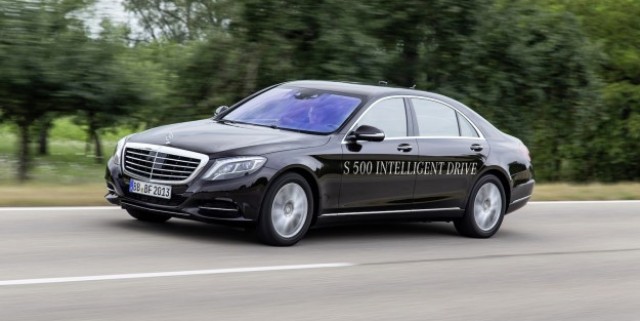
A Mercedes-Benz S-Class has driven without driver input for a total of 125km through city streets and arterials in Germany.
In order to highlight future self-driving technologies, Mercedes-Benz chose the route that that Bertha Benz (wife of company founder and engineer Carl Benz) took in August 1888 between Mannheim and Pforzheim to demonstrate the long-distance potential of the automobile. Unlike 125 years ago, Mercedes-Benz notes, the S500 Intelligent Drive did not have the road all to itself but had to “negotiate dense traffic and complex traffic situations”.
The autonomous-driving S-Class, called S500 Intelligent Drive, not only looks barely different from a production variant, but it mostly used the standard 28 cameras, sensors and radars to perform the task of braking, accelerating and steering through public roads.
Mercedes-Benz also took the standard front stereo camera, then increased the base width, which acts as extra “distance between the eyes”, and then added a further nine camera or radars, including: two long range radars at the front sides of the vehicle to provide earlier detection of cars approaching left and right at junctions; four short-range radars at each corner to more clearly detect pedestrians and other surroundings; a colour camera behind the windshield with a 90-degree opening angle to detect traffic lights; a rear radar to monitor rear traffic; and a further rear camera to analyse the environment that the car had just driven past and cross-check it with the GPS system.
Although there were hardware additions – including a larger-capacity hard-drive because the front stereo camera along uses 300gb of data per hour – Mercedes-Benz claims that the S500 Intelligent Drive uses “only those sensor technologies that are already use in similar form in Mercedes-Benz standard-production vehicles,” which are “already affordable and suitable for everyday use.”
Yet developers also had to teach the software to know where the car is, what is sees and how to react autonomously. Algorithms were developed in conjunction with the Institute for Measuring Control Technology at the Karlsrue Institute of Technology (KIT). An off-shoot of Nokia, called HERE, also helped produce 3D digital maps of the selected route, which includes lane markings, and positioning of traffic lights and signs, and also must be more accurate than regular sat-nav systems.
Route Pilot, which in the production S-Class slows the car to a stop then accelerates from stand-still, also needed to cope with “unpredictable” real-world traffic scenarios, with Mercedes-Benz acknowledging that “no driving situation is exactly the same as an earlier one”. Over intense testing, which began in early 2012, engineers were able to teach the system how to react in varied situations – such as, in Europe, allowing right-before-left priority at junctions, and distinguishing red-arrow lights from the straight-ahead.
Mercedes-Benz cites curious situations as examples of the test cars still being less able than a human driver, such as if the car stops at a pedestrian crossing because it identifies people, yet if those people wave the car through, the car remains at a standstill. Mercedes-Benz also doesn’t want the system to master every situation on its own, giving the example that if a self-driving vehicle gets stuck behind a dump truck, it won’t have the ability to see ‘around’ it and therefore cannot decide automatically whether it should over-take on the other side of the road or not.
While the company says the advantages of autonomous driving are obvious – such as allowing motorists to reach their destination in a more relaxed state, improving safety by eliminating driver error, and ending the tedious task of peak-hour driving – it also says the intention is not to remove the driver from the equation.
“Our autonomous systems offer to assist and unburden the driver,” argues head of Mercedes-Benz Cars development Professor Thomas Weber. “Those who want to drive themselves are free to do so, and that won’t change in the future either.”
Regardless, by current laws in Germany a driver has to be present in a self-driving car, as was the case with the S500 Intelligent Drive test route. Other legal implications, such as who would be at fault if there were an accident – self-driving car or driver – and laws stating that at speeds beyond 10km/h the car cannot automatically make large steering inputs are, Benz executives admit, huge hurdles that mean the ability to put the S500 Intelligent Drive into production is “technically feasible [but] still not universally permitted.”





